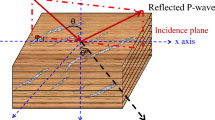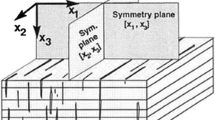Abstract
Fracture orientation and in particular the fracture strike play an important role in guiding the accurate estimation of the orientation of in situ stress fields. Fracture strike can be extracted based on the azimuthal seismic reflection responses. Thus, the characteristics of seismic reflection responses varying with fracture strike are critical for fracture strike estimation. In this work, a set of vertical fractures with different strikes is introduced into an isotropic host matrix based on the Schoenberg linear-slip theory, and the azimuthal seismic reflection response is modeled based on the reflection/transmission analysis at a plane interface. The effect of fracture parameters, i.e., fracture density, fracture aspect ratio, and fluid infill on the seismic reflection response, is analyzed. The influences of fracture strike on the stiffness matrix are simulated, and we further discuss the impacts on the P- and S-wave velocities. The influences of fracture strike on the reflection coefficient are depicted using the rose diagram method. The proposed workflow is applied to real seismic reflection data. The method is used to estimate the fracture strike with the seismic data in the Sichuan Basin work area by assuming that all fractures are vertically oriented, and the rose diagram is obtained close to the target layer. The results show that the fracture strike predicted by the method is in good agreement with the estimation based on the well-bore imaging data.
















Similar content being viewed by others
Data Availability
The data can be accessed by contacting the corresponding author.
References
Afzal, D. M. Z., Atif, R. S., Maryam, T., Ghulam, S., & Bakhtawer, S. (2022). Characterization of seismic anisotropy using azimuthal AVO analysis (AVAz)—An application case study in the deep and tight carbonate reservoirs from Potwar Basin onshore Pakistan. Journal of Applied Geophysics, 205(1), 104767. https://doi.org/10.1016/J.JAPPGEO.2022.104767
Al-Marzoug, A. M. (2006). P-wave anisotropy from azimuthal AVO and velocity estimates using 3D seismic data from Saudi Arabia. Geophysics, 71(2), E7–E11. https://doi.org/10.1190/1.2187724
Bachrach, R., Sengupta, M., Salama, A., & Miller, P. (2009). Reconstruction of the layer anisotropic elastic parameter and high-resolution fracture characterization from P-wave data: A case study using seismic inversion and Bayesian rock physics parameter estimation. Geophysical Prospecting, 57(2), 253–262. https://doi.org/10.1111/j.1365-2478.2008.00768.x
Bahorich, M., & Farmer, S. (1995). 3-D seismic discontinuity for faults and stratigraphic features: The coherence cube. SEG Technical Program Expanded Abstracts, 14(10), 1053–1058. https://doi.org/10.1190/1.1887523
Chopra, S., & Marfurt, K. J. (2007). Curvature attribute applications to 3D surface seismic data. The Leading Edge, 26(4), 404–414. https://doi.org/10.1190/1.2723201
Crampin, S. (1981). A review of wave motion in anisotropic and cracked elastic-media. Wave Motion, 3(4), 343–391. https://doi.org/10.1016/0165-2125(81)90026-3
Crampin, S. (1985). Evaluation of anisotropy by shear-wave splitting. Geophysics, 50(1), 142–152. https://doi.org/10.1190/1.1441824
Dorigo, M., Maniezzo, V., & Colorni, A. (1996). Ant system: Optimization by a colony of cooperating agents. IEEE Transactions on Systems Man and Cybernetics (part B), 26(1), 29–41. https://doi.org/10.1109/3477.484436
Downton, J., & Roure, B. (2010). Azimuthal simultaneous elastic inversion for fracture detection. SEG Technical Program Expanded Abstracts, 29, 263–267. https://doi.org/10.1190/1.3513389
Downton, J., & Roure, B. (2015). Interpreting azimuthal Fourier coefficients for anisotropic and fracture parameters. Interpretation, 3(3), ST9-ST27. https://doi.org/10.1190/INT-2014-0235.1
Gong, L., Gao, S., Liu, B., Yang, J., Fu, X., Xiao, F., et al. (2021a). Quantitative prediction of natural fractures in shale oil reservoirs. Geofluids, 2021(3), 1–15. https://doi.org/10.1155/2021/5571855
Gong, L., Wang, J., Gao, S., Fu, X., Liu, B., Miao, F., et al. (2021b). Characterization, controlling factors and evolution of fracture effectiveness in shale oil reservoirs. Journal of Petroleum Science and Engineering, 203(2), 108655. https://doi.org/10.1016/j.petrol.2021b.108655
Hsu, C. J., & Schoenberg, M. (1993). Elastic waves through a simulated fractured medium. Geophysics, 58(7), 964–977. https://doi.org/10.1190/1.1443487
Huang, G., Ba, J., Gei Davide, M., & Jose, Carcione. (2022). A matrix-fracture-fluid decoupled PP reflection coefficient approximation for seismic inversion in tilted transversely isotropic media. Geophysics, 87(6), 275–292. https://doi.org/10.1190/GEO2021-0631.1
Hudson, J. A. (1981). Wave speeds and attenuation of elastic waves in material containing cracks. Geophysical Journal International, 64(1), 133–150. https://doi.org/10.1111/j.1365-246X.1981.tb02662.x
Li, T. (1999). Fracture signatures on P-wave AVOZ. SEG Technical Program Expanded Abstracts, 15(1), 1818–1821. https://doi.org/10.1190/1.1826490
Li, L., Guo, Y., Zhang, X., Pan, X., Zhang, J., & Lin, Y. (2022). Seismic characterization of in situ stress in orthorhombic shale reservoirs using anisotropic extended elastic impedance inversion. Geophysics, 87(6), 1–68. https://doi.org/10.1190/geo2021-0807.1
Li, Y. W., Sun, W., Liu, X., Zhang, D., Wang, Y., & Liu, Z. (2018). Study of the relationship between fractures and highly productive shale gas zones, Longmaxi Formation, Jiaoshiba area in eastern Sichuan. Petroleum Science, 15(3), 498–509. https://doi.org/10.1007/s12182-018-0249-7
Lisle, R. J. (1994). Detection of zones of abnormal strains in structures using Gaussian curvature analysis. AAPG Bulletin, 1994(78), 1811–1819. https://doi.org/10.1306/A25FF305-171B-11D7-8645000102C1865D
Liu, X., Guo, Z., & Han, X. (2018a). Full waveform seismic AVAZ signatures of anisotropic shales by integrated rock physics and the reflectivity method. Journal of Geophysics and Engineering. https://doi.org/10.1088/1742-2140/aaa3d3
Liu, Y., Liu, X., Lu, Y., Chen, Y., & Liu, Z. (2018b). Fracture prediction approach for oil- bearing reservoir based on AVAZ attributes in orthorhombic medium. Petroleum Science, 15(3), 510–520. https://doi.org/10.1007/s12182-018-0250-1
Liu, Y., Zhu, Z., Pan, R., Gao, B., & Jin, J. (2022). Analysis of AVAZ seismic forward modeling of fracture-cavity reservoirs of the dengying formation, Central Sichuan Basin. Energies, 15(14), 5022. https://doi.org/10.3390/EN15145022
Long, P., Zhang, J., & Tang, X. (2011). Feature of muddy shale fissure and its effect for shale gas exploration and development. Natural Gas Geoscience, 22(3), 525–532.
Lyu, W., Zeng, L., Zhang, B., Miao, F., Lyu, P., & Dong, S. (2017). Influence of natural fractures on gas accumulation in the Upper Triassic tight gas sandstones in the northwestern Sichuan Basin, China. Marine and Petroleum Geology, 83, 60–72. https://doi.org/10.1016/j.marpetgeo.2017.03.004
Mallick, S., Craft, K. L., Meister, L. J., & Chambers, R. E. (1998). Determination of the principal directions of azimuthal anisotropy from P-wave seismic data. Geophysics, 63, 692–706. https://doi.org/10.1190/1.1444369
Marfurt, K. J., Kirlin, R. L., Farmer, S. L., et al. (1998). 3-D seismic attributes using a emblance-based coherency algorithm. Geophysics, 63(4), 1150–1165.
Pan, B., Mrinal, K. S., & Gu, H. (2016). Joint inversion of PP and PS AVAZ data to estimate the fluid indicator in HTI medium: A case study in Western Sichuan Basin, China. Journal of Geophysics and Engineering. https://doi.org/10.1088/1742-2132/13/5/690
Pan, X., Zhang, G., Chen, H., & Yin, X. (2017). McMC-based AVAZ direct inversion for fracture weaknesses. Journal of Applied Geophysics. https://doi.org/10.1016/j.jappgeo.2017.01.015
Penersen, S. I., & Skov, T. (2002). Automatic fault extraction using artificial ants. SEG Technical Program Expanded Abstracts, 21, 512–515. https://doi.org/10.1190/1.1817297
Pedersen, S. I., Skov, T., Hetlelid, A., Fayemendy, P., Ramden, T. & Sonneland, L. (2003). New paradigm of fault interpretation: 73rd Annual International meeting SEG Technical Program Expanded Abstracts: Society of Exploration Geophysicists, pp 350–353.
Randen, T., Pedersen, S. I., & Snneland, L. (2001). Automatic detection and extraction of faults from three-dimensional seismic data: 71st Annual International meeting SEG Technical Program Expanded Abstracts: Society of Exploration Geophysicists, pp 551–555.
Rüger, A. (1998). Variation of P-wave reflectivity with offset and azimuth in anisotropic media. Geophysics, 63(3), 935–947. https://doi.org/10.1190/1.1444405
Rüger, A. (2002). Reflection coefficients and azimuthal AVO analysis in anisotropic media. Society of Exploration Geophysicists. https://doi.org/10.1190/1.9781560801764
Sayers, C. M., & Dean, S. (2001). Azimuth-dependent AVO in reservoirs containing non-orthogonal fracture sets. Geophysical Prospecting, 49(1), 100–106. https://doi.org/10.1046/j.1365-2478.2001.00236.x
Schoenberg, M. (1980). Elastic wave behavior across linear slip interfaces. The Journal of the Acoustical Society of America, 68(5), 1516–1521. https://doi.org/10.1121/1.385077
Schoenberg, M., Dean, S., & Sayers, C. M. (1999). Azimuth-dependent tuning of seismic waves reflected from fractured reservoirs. Geophysics, 64(4), 1160–1171. https://doi.org/10.1190/1.1444623
Schoenberg, M., & Douma, J. (1988). Elastic wave propagation in media with parallel fractures and aligned cracks. Geophysical Prospecting, 36(6), 571–590. https://doi.org/10.1111/j.1365-2478.1988.tb02181.x
Schoenberg, M., & Sayers, C. M. (1995). Seismic anisotropy of fractured rock. Geophysics, 60, 204–211. https://doi.org/10.1190/1.1443748
Shaw, R. K., & Sen, M. K. (2004). Born integral, Stationary phase and linearized reflection coefficients in weak anisotropic media. Geophysical Journal International, 158(1), 225–238. https://doi.org/10.1111/j.1365-246X.2004.02283.x
Shaw, R. K., & Sen, M. K. (2006). Use of AVOA data to estimate fluid indicator in a vertically fractured medium. Geophysics, 71(3), C15–C24. https://doi.org/10.1190/1.2194896
Teng, L. (1998). Seismic and rock-physics characterization of fractured reservoirs. Stanford University.
Thomsen, L. (1986). Weak elastic anisotropy. Geophysics, 51(10), 1954–1966. https://doi.org/10.1190/1.1442051
Wang, J., Zhang, J., & Wu, G. (2021). Wide-azimuth Young’s modulus inversion and fracture prediction: An example of H structure in Bozhong sag. Oil Geophysical Prospecting, 56(3), 593–602.
Yin, X., Liu, Z., Li, C., Li, A., & Gai, H. (2014). Fracture formation prediction with a steady azimuth AVO gradient unconstrained inversion method. Geophysical Prospecting for Petroleum, 53(6), 683–691. https://doi.org/10.3969/j.issn.1000-1441.2014.06.008
Zhao W., Sun, D., Zhang, T., Lin, Y., Bie, J., & Li, J. (2018). Application of improved ant-tracking method in carbonate-fracture reservoir. In: 88th Annual International meeting SEG Technical Program Expanded Abstracts: Society of Exploration Geophysicists, pp 1633–1638. https://doi.org/10.1190/segam2018-2997357.1
Acknowledgements
This work is supported by the National Natural Science Foundation of China (grant no. 41974123 and 42174161) and the Jiangsu Innovation and Entrepreneurship Plan.
Author information
Authors and Affiliations
Contributions
JB: supervision, modeling, writing-reviewing and funding acquisition. WZ: methodology, modeling, writing and draft preparation. GH: software, validation, editing and writing. TMM: writing-reviewing and suggestion. CL: writing-reviewing. All authors contributed to the article and approved the submitted version.
Corresponding author
Ethics declarations
Conflict of Interest
The authors declare no competing interests.
Additional information
Publisher's Note
Springer Nature remains neutral with regard to jurisdictional claims in published maps and institutional affiliations.
Appendix A: Calculation formulas of \(\xi\) and \(\eta\) in Eq. 6
Appendix A: Calculation formulas of \(\xi\) and \(\eta\) in Eq. 6
where the corresponding parameters \(\eta_{mn}\) are determined.
and
where \(a_{{\text{b}}}\) represents the P-wave velocity of the host medium. and \(\varphi\) denotes the azimuth angle.
Rights and permissions
Springer Nature or its licensor (e.g. a society or other partner) holds exclusive rights to this article under a publishing agreement with the author(s) or other rightsholder(s); author self-archiving of the accepted manuscript version of this article is solely governed by the terms of such publishing agreement and applicable law.
About this article
Cite this article
Ba, J., Zhang, W., Huang, G. et al. Rock Physics Modeling and Seismic AVAZ Responses of Fractured Reservoirs with Different Azimuths. Pure Appl. Geophys. 180, 951–968 (2023). https://doi.org/10.1007/s00024-023-03240-y
Received:
Revised:
Accepted:
Published:
Issue Date:
DOI: https://doi.org/10.1007/s00024-023-03240-y




